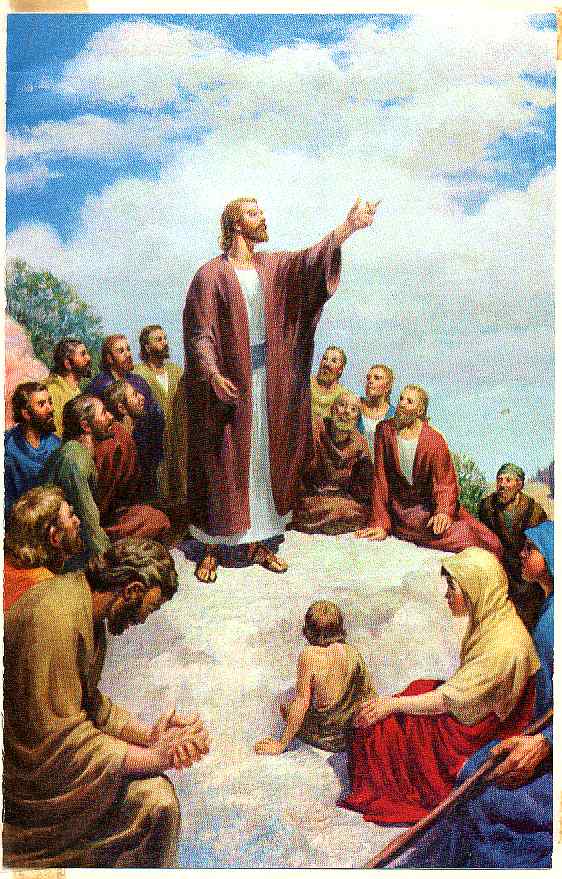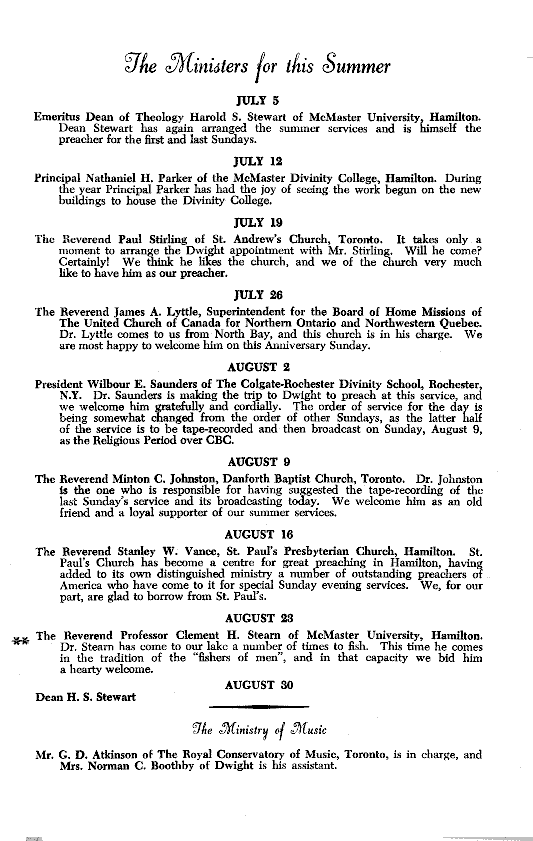
Table of Contents
Previous: The Cottages
Next: Family Material
V. THE CHURCHIn a remarkable way the church - now The Stewart Memorial Church - has been the focal point of our family life at Dwight. The stories of grandfather and of father have indicated their connection with the church, and their deep interest in it. Since father ceased to care for the summer services that duty has, by wish of the members, fallen to me. Since 1959, however, my responsibility has been shared with a committee, so that in case I had to cease to function the services would still have continuity. I have never followed Father's plan of being the regular preacher, but rather I have shared the pulpit with others who have generously consented to help. This change of policy has seemed justified by the continued and increased interest of the summer community and of the Dwight residents in the services. Nellie Haysum and Sam Wells were the first couple to be married in the church, May 22, 1888. Grandfather performed the ceremony. On February 5, 1954 I called on Mrs. Wells at Rest Haven on Wentworth Street South, Hamilton, where she was being cared for shortly before her death. She told me that there was a Mr. Lambert (Rev. Wm. Lambert of Orillia) who did religious work at Dwight before the church was organized, but that grandfather organized the church. He had worked for several seasons among the people, and in the summer of 1887, largely through his efforts, the building was erected and dedicated. (See later page with reproduction of the opening announcement) To this dedication father came from Rochester to be the preacher, and from this visit the interest of our family in Dwight as a summer home may well be dated.. A member of my Philadelphia church, Mrs. Alexander, who was a daughter of Mr. Osborne, for whom the portage between Peninsula Lake and the Lake of Bays was named, told me she remembered attending the services of dedication. The church was organized as a Baptist church, and its records appear in the minutes of the Collingwood Association to which it belonged. For several years after the organization the Home Missionary Society of the Baptist Convention of Ontario and Québec sent a summer supply to the field - a divinity student from McMaster University, no doubt. I remember two at least, Mr. George and Mr. Brown. But for the Sundays of father's vacation he was always the one in charge, and almost always preached. In view of father's presence on the field the sending of student ministers for the summer was soon given up. My experience in Ontario suggests that this occurred because there were so many other fields needing their help. And so for fifty summers Father was minister of the Baptist Church at Dwight. Not only so, but Mother, Josephine, and later, Isabel, played the organ. The care of the pulpit flowers also fell to the family. Hilda was sometimes the soloist, and a journey from her father's summer home to Dwight to sing was very close to the beginning of the romance which brought her into the family - a romance which has now covered fifty years of married life. Fred was frequently the soloist, and four of the boys formed a quartette which again and again rendered the special music. So in these and in many other ways the family was bound to the church. When Father, because of his years, gave up the active ministry of the church he felt that the time had come to establish its future. This could not be with Baptists, for almost all of the Baptist members had moved away or had died, and there were no new Baptist recruits. In fact the church had become largely a summer church for a summer community and those settlers who were interested. Meantime the United Church of Canada had come into existence, and the Dwight Presbyterian Church (St. Peter's) had gone into union. A Larger Parish, under the name, The Muskoka United Charge, with a settled group of ministers had been established. Placing the building in the hands of this United Charge for its use in the community by giving it to the membership of St.Peter's Church, seemed the wise way of insuring the perpetuation of its unique summer mission. Father persuaded Mr. Fred Emberson - almost the sole surviving member of the church - to this view, and after proper arrangements had been gone through with, the property was transferred. At a meeting of the two congregations, held September 20, 1936, at which Father presided, and the Rev. J. C. Cochran, D. D., representing the United Church, and the local minister, Rev. J. F. V. Morris, were present, the transfer was made. At this same meeting Mrs. Archie Gouldie suggested, and her suggestion was put into effect, that the church now be named, in honor of its founder Rev. Alexander Stewart, The Stewart Memorial Church.. Many ministers of note have occupied the pulpit of the church from time to time. Congregations have always been good, not only in recent years when, with the aid of the P. A. system the outdoor congregation overflowing from the sanctuary hears the service, but also in the early years, when, on the occasion of the great Union Services, farmers drew their wagons up alongside the windows so as to hear what was going on inside. In the early days settlers came in boats on Sunday morning. Sometimes for special services the steamboat would make an excursion to Dwight. And men from ever so far back from Emberson's and Cain's Corners, walked in miles and miles. Once some young men were said to have walked in sixteen miles to morning service. The church still stands as it was built, except that the belfry with the bell in memory of Mother, given by her children, has been added. There have been memorial gifts, also. Among them, pulpit chairs given by Walter Burrill in memory of his first wife, Beatrice; the pulpit Bible given in memory of Alan Walker by his wife, Elma; and an antique bronze vase for flowers, placed by the Hospital Bandage Group of which Isabel was a member in Hamilton, in her memory. The Children's CongregationTowards the end of the summer of 1953, Dorothy Stewart and Madeline Welch made a fine suggestion, namely that there should be a children's congregation cared for apart from the main congregation during the latter part of the morning service period. The children would leave the church during the singing of the second hymn and have their own program on the grass, or on the verandah at the Pine Cone, or inside if the weather was inclement. The girls undertook working out details for the programs and for the supervision of the children. This would be an advantage to the children, to whom the sermon period was not adapted, and there would be advantage to the parents who wished to attend church but hesitated to bring very young children whom they could not well leave at home. The plan was enthusiastically accepted by all concerned, and it was put into practice on Sunday, July 11, 1954. Children from the ages of four to twelve were brought to church by their parents or friends. Following the morning prayer a story was told each Sunday to the children. Then they assembled around the organ and sang together one stanza of "Jesus loves me". The adults in charge - almost always Dorothy and Madeline themselves - then led the little ones through the back door and down the ramp and across to The Pine Cone. There, on favorable days, they were given instruction and handwork outdoors, and on cold or rainy Sundays, indoors around the fireplace. Dorothy and Madeline carried on for seven summers, and then the leadership in the work has handed over to Mrs. Ralph Richardson. From about fifteen to fifty children have attended each Sunday, and their parents have been delighted with the arrangement. Nothing enlists the attention of the general congregation more than the children's singing and their recessional. When church is over the children come running to their parents with their handwork to show what they have been doing. Probably this feature represents the most notable change in the church service since services began away back in 1887. |
Children's Recessional, after the
Children's Story.
(Note some of the general church congregation seated about the door)

| Calendars, such as the one below, have been supplied for church use through the interest and kindness of Harold Welch. They aid the service, help in the church publicity, and serve as souvenirs. |
Church calendar and order of service

inside left page

inside right page

| In the early days Godlip Wood lived at the entrance of Dwight Bay, just back of Poverty Point. Recently his grandson, Jim Wood, came across a hand-bill that had teen preserved among his grandfather's papers, announcing the opening of the Baptist Church at Dwight. Alex had copies of the hand-bill made, of which the following is one. |
|
| About the year 1950 the church began the use of announcement cards which are distributed from the Post Office and on Sundays from the church. These have been effective in increasing and informing the congregation. |
.gif)
Table of Contents
Previous: The Cottages
Next: Family Material